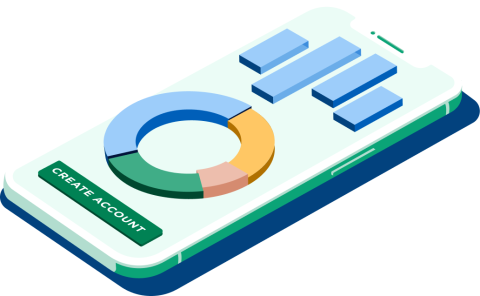Making money with Bitcoin (BTC) has become increasingly complicated. Prices are volatile. Promises of free Bitcoin are often scams. Bitcoin mining, once accessible to individual investors, is now so competitive that it’s rarely a profitable venture for those with small setups.
However, it’s still possible to make money with Bitcoin. You can trade it, lend it, hold it or earn it. Returns aren’t guaranteed on this volatile asset; just as you can make money as the price goes up, it’s also possible you could lose money if the price goes down. But Bitcoin’s growth since launching makes some crypto investors bullish about its future: In 2010, 1 Bitcoin was worth about 9 cents, and as of this writing, each coin is worth around $72,000.
Advertisement
|
NerdWallet rating
4.9 /5 |
NerdWallet rating
5.0 /5 |
NerdWallet rating
4.1 /5 |
|
Fees $0 per online equity trade |
||
|
Promotion None no promotion available at this time |
Promotion None no promotion available at this time |
Promotion Get up to $700 when you open and fund a J.P. Morgan Self-Directed Investing account with qualifying new money. |
Holding Bitcoin
Return: Depends on size of investment and price changes. In its current bull run, Bitcoin prices have touched all-time highs of more than $70,000.
Buying and holding Bitcoin as a long-term investment — or, as some crypto enthusiasts call it, HODLing — can be a low-effort way to make money in the long term, as long as its price when you finally sell it is higher than the price at which you bought it.
Bitcoin was originally conceived as a cryptocurrency that could be used for day-to-day transactions, but as its value increased, many investors have started to view Bitcoin as a long-term investment. As with any investment, holding for a longer period of time means you’ll have to endure ups and downs in pricing without being tempted to buy or sell. If you choose to buy and hold Bitcoin, you’ll want to make sure you’re not over-exposed to any one asset and that you’re not investing money you can’t afford to lose. One guideline is to invest no more than 10% of your portfolio into risky assets like Bitcoin.
How about Bitcoin ETFs?
In January 2024, the Securities and Exchange Commission approved a handful of spot Bitcoin ETFs. These allow investors — including 401(k) investors, who were previously unable to directly access Bitcoin through their retirement accounts — to gain exposure to the cryptocurrency.
On the one hand, Bitcoin ETFs provide an easy way for fund-oriented investors, such as those with retirement accounts, to allocate a portion of their portfolio to cryptocurrency for the sake of investment diversification. On the other, they lack many of the benefits of actual cryptocurrency ownership — you can’t spend it or store in a cold wallet. And they may be subject to just as much volatility as Bitcoin itself.
Using a credit card with Bitcoin rewards
Return: Generally 5% or less per dollar spent on certain categories and 1% on all other purchases.
There are many crypto credit cards that will allow you to earn rewards in cryptocurrency. Similar to traditional cash-back programs, you can earn a small percentage of the purchases you make with the card, which can be paid out in Bitcoin or other cryptocurrencies. Some offer sign-up bonuses that allow you to earn additional rewards if you meet certain criteria.
Keep in mind that your crypto rewards might be reduced by transaction fees or a spread added by the provider. A spread is the difference between the market price and the rate provided by a certain platform; when the issuer of a crypto credit card has one that applies to rewards, it means you’ll get a slightly less favorable exchange rate when both earning and selling those crypto rewards.
Lending Bitcoin
If you already own some Bitcoin, you can earn interest on your assets by lending to other investors or institutions. There are several platforms that let you lend out your Bitcoin in return for interest.
However, each platform has stipulations for lending worth digging into. For instance, you could lose some or all of your investment if the borrower you’re lending to defaults. Crypto lending is also a relatively new category and carries a high level of risk and uncertainty. Notably, multiple platforms stopped offering lending services in 2022. On Nov. 16, 2022, Gemini told customers they might be unable to withdraw funds from Gemini Earn, and indeed those funds were frozen for users for over a year.
However, In Feb. 2024, the New York State Department of Financial Services announced that Gemini would return at least $1.1 billion to customers who lost funds in 2022 .
Advertisement
|
NerdWallet rating
4.8 /5 |
NerdWallet rating
3.9 /5 |
NerdWallet rating
3.5 /5 |
|
Fees 0% – 3.99% varies by type of transaction; other fees may apply |
||
|
Promotion Get $200 in crypto when you sign up. Terms Apply. |
Promotion None no promotion available at this time |
Promotion None no promotion available at this time |
Accepting payments or tips in Bitcoin
Return: Depends on amount of payments in Bitcoin and price movement.
If you accept payments or tips for side gigs or a business, consider giving people the option to pay in Bitcoin. You can do this with platforms with processing services such as Coinbase or BitPay.
The setup is relatively simple, though navigating the tax implications and risk associated with accepting Bitcoin payments can be more complicated. Coinbase’s self-managed account can be set up immediately. BitPay takes a few days to get approved but allows you to accept several cryptocurrencies.
Something to keep in mind: If having exposure to Bitcoin is your goal, be sure to use a service that allows you to accept funds in Bitcoin. While BitPay and Coinbase give you the option to receive funds this way, some processors only allow you to accept funds in fiat money.
Day-trading Bitcoin
Return: Depends on size of investment, trades and price changes.
It’s technically possible to make money by buying and selling Bitcoin within short windows, moving in and out of positions as the market changes. But similar to day trading with stocks, it’s far more likely you will lose money this way.
Stock day traders use macro- and microeconomic data, market trends that date back to the beginning of the stock market, and other tools at their disposal in order to make educated guesses at which stocks to buy or sell. And still, these active traders struggle to match the returns that can come from buying and holding, say, low-cost funds that track a broad market index.
Investors have far less data about the behavior of Bitcoin under certain economic conditions, so predicting its price movements can be even more difficult. Additionally, trading cryptocurrency on a regular basis can quickly become a nightmare during tax season. You’ll need to be diligent about keeping records of what you bought and sold and the different price points involved. If you’re thinking about becoming a frequent cryptocurrency trader, it’s a good idea to speak with your accountant and make sure you know what to keep track of before getting started.
Some volatility is necessary to make money through day trading; prices need to move up or down for a trader to be able to make a profit. But Bitcoin and crypto are more volatile than other assets, and that makes an already deceptively difficult notion like “buy low and sell high” even more of a challenge. If you’re intent on giving this a try, start small and be cautious.
Track your finances all in one place
Get started by signing up and linking an account.

What about Bitcoin mining?
Bitcoin mining can be a lucrative way to make money with Bitcoin, but not for individual investors. Because of the computing power required, the upfront and ongoing costs can far outpace mining rewards earned.
Bitcoin’s blockchain operates using a proof-of-work consensus mechanism, which means that miners perform the essential task of validating transactions in order to keep the network secure. New blocks of transactions are added to the ledger once every 10 minutes, and the miner who validates a new block is rewarded 6.25 Bitcoins. Miners also earn transaction fees paid by users who would like to have their transactions validated faster, which can add about $4,000 to the reward for each block.
But to have a chance at earning a Bitcoin reward for validating a block of transactions, you’ll need a powerful computer known as an ASIC (or application-specific integrated circuit), and these can cost over $10,000. You’ll also need to spend thousands on electricity to compete with other miners, and earnings aren’t guaranteed.
There are mining pools that exist, where investors can pool computational resources and share rewards for mining Bitcoin. But the setup isn’t any simpler. Pools charge fees for their users, and the larger the pool is, the smaller the reward will be.
Neither the author nor editor held positions in the aforementioned investments at the time of publication.





